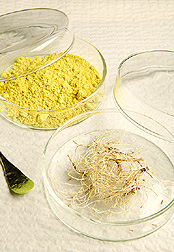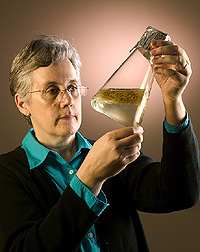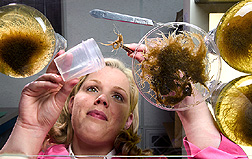Rooting for Gossypol: Intriguing cotton roots make
a compound that could benefit agriculture—and even medicine
Plant physiologist Barbara Triplett understands how opportunity can arise even as disease strikes.
In her New Orleans, Louisiana, laboratory, she’s pricked a cotton seedling’s tender, new leaf with a toothpick, purposely injecting a bacterium that will cause stubs to sprout from the wound sites. In just a few weeks, these stubs will become tendrils of fine, waving roots.
These so-called hairy roots owe their dramatic growth to a particular kind of disease-causing bacterium found in soil, Rhizobium rhizogenes.
“Once the bacterium invades plant leaf cells, it signals them to create lots of hairy roots,” explains Triplett, who works at ARS’s Southern Regional Research Center (SRRC).
Despite their odd origins, these leaf-based roots—and more importantly, the compounds they produce—stand to help an array of researchers, from those studying complex plant-pathogen interactions to those at the forefront of cancer research.
Phytochemical Factories
|
|
Inoculating plant tissues in petri dishes with root-instigating bacteria, like R. rhizogenes, has been a tool of scientists for nearly 25 years.
“Hairy-root cultures, which can be derived from a variety of plant species, are being used to produce secondary plant metabolites—such as isoflavonoids, terpenoids, and alkaloids—that could be of pharmaceutical interest,” says Triplett.
Tissue and cell cultures have become increasingly important to researchers who study plant compounds, since supplies of source plants are often limited. Original specimens may be found only in remote places or in areas experiencing environmental change and habitat loss.
“Another advantage of plant cultures is that they grow in the laboratory and can produce compounds steadily throughout the year,” Triplett adds. “Our hairy roots from cotton are still growing in petri dishes and flasks in the lab, but other researchers have scaled-up hairy-root cultures to large-scale bioreactors for commercial production.”
The roots may also yield answers to some perplexing agricultural questions, says Lawrence Young, research leader of the Crop Genetics and Production Research Unit in Stoneville, Mississippi. He’s studying a serious cotton pest, the reniform nematode, which destroys about 10 percent of Mississippi’s cotton crop each year.
The cultured roots provide Young with an unfettered view of how cotton plants might fend off a nematode attack. “With the hairy roots,” he explains, “we can grow nematodes on a clean culture, away from potentially contaminating soil fungi and bacteria. Then we can collect RNA from plant cells near where the nematodes are feeding to learn about the plant’s specific defense responses.”
But, by far, most of the interest is focused on a yellow pigment—gossypol—produced by the cotton plant’s prolific roots. Also found in cotton seeds, leaves, and stems, this pigment accumulates in the plant’s outer tissues to shield them from damaging insects. And because of its bitter taste, gossypol aids fledgling plants by keeping grazing herbivores away.
“Gossypol has long been studied by ARS scientists, because in some circumstances it can be toxic or cause fertility problems in livestock,” says Triplett. “But it’s now being investigated for its abilities to suppress numerous microbes, parasites, fungi, and insects—and for inhibiting growth of some cancers.”
Laying Down Roots
While gossypol is found in cottonseed, there are limited methods for extracting large quantities of it. So about 2 years ago, Triplett began studies of whether hairy root cultures from cotton could produce it abundantly.
But she had many questions to consider: Which cotton species produce the most gossypol? Which plant parts best sprout hairy roots? Would root cultures be stable enough to create gossypol over a long period?
“Even though a plant tissue makes a compound, there’s no guarantee that it will produce it continuously in culture,” Triplett says. But with the help of undergraduate student Stephanie Moss, Triplett has been able to coax roots into producing impressive amounts of gossypol.
“We’ve gone from 100 hairy root lines to 10, experimenting with different media and hormones to see which ones yield the most gossypol—and the gossypol derivatives with the greatest biological activity,” Triplett says. “We’re seeing a very high level of production without having to do very much to the system. I can’t recall too many things in my career that have worked so well.”
Even so, Triplett believes they have yet to find the roots’ true potential for making the promising compound. She and Moss will continue to experiment with temperature, pH, and hormones to further boost production.
Like Crystallizing Liquid Gold
|
|
Some of the gossypol made by the plant tissues is secreted in the culture’s liquid medium, giving it a rich, amber glow. The hairy roots retain the rest.
It’s up to ARS chemical engineer Michael Dowd to analyze culture samples and confirm that the compound’s really there. By using high-performance liquid chromatography, he’s also determining which forms of gossypol, and what related compounds, the cultures contain.
In cotton plants, gossypol exists in two different forms, or isomers. The two forms are mirror images of one another. Though they seem so similar, mirror images are not identical.
Dowd offers an analogy. “Think of your hands,” he says. “They’re mirror images of one another. But if you place them side by side, or one on top of the other, your thumbs will go in opposite directions.”
Because of their “handedness,” these compounds are said to be chiral, named after the Greek word for hand, chir . Chiral isomers are chemically similar to one another, sharing the same boiling point, for instance, but they differ in their biological activity and potency.
Chirality makes gossypol difficult to analyze and separate. But through much diligence—and some luck—Dowd found a way to isolate the compound’s two valuable isomers.
“Late one Friday evening, I left a solution of gossypol in the lab’s freezer,” he says. “When I returned, I saw that it had started to form crystals, as some compounds do under certain conditions. I knew from their properties that they were different, but it wasn’t until much later that I realized that the crystals had separated into the two chiral forms of gossypol.”
Dowd’s intent was to crystallize gossypol, but he had no idea the crystals would be of the conglomerate type—a mixture of two different forms, each containing only one of the compound’s two isomers.
“Louis Pasteur discovered conglomerate crystals while working with tartaric acid,” Dowd explains. “He could see two distinct crystals, each with a different habit, or shape. He was even able to sort the tiny crystals by hand.”
Dowd’s finding was an important breakthrough, since otherwise a lot of chemistry would be needed to separate and purify the compound’s two isomers. But why all the trouble to break them apart?
“Each type of gossypol has unique capabilities,” says Dowd. “One form is called the (+) isomer because it rotates polarized light to the right, in a positive direction. It’s been shown to be less toxic to animals but still have effects on insects, fungi, and microbes. The (–) form, which rotates polarized light to the left, is of interest to cancer researchers.”
Every week, Dowd produces several grams of pure chiral gossypol—a bright-yellow powder he keeps in the dark because of its light sensitivity. For now, he’s able to meet researchers’ demands for the compound’s (+) and (–) forms. He’s sharing samples with researchers across the globe, including Young Lin, a professor from Ohio State University in Columbus, Ohio, who’s studying gossypol as an anticancer agent.
“We’re examining the effectiveness of gossypol from cottonseed as a preventive agent for breast and prostate cancer,” says Lin. “With the help of SRRC researchers, we’ve been able to identify (–) gossypol as the most potent form.”
If his studies continue to confirm gossypol’s anticancer activity, Lin hopes to collaborate with ARS researchers to develop products from cottonseed meal that would act as therapeutic or preventive agents for human breast cancer.
Ironically, most of the gossypol coming from cotton plants is currently being discarded or consumed by livestock on the farm. “We have tons of cottonseed in this country just being fed to cows,” says Triplett. “If gossypol continues to show promise for medicinal and agricultural applications, it could bring a vastly improved value to the cotton crop.”—By Erin K. Peabody, Agricultural Research Service Information Staff.
This research is part of Plant Biological and Molecular Processes (#302) and Quality and Utilization of Agricultural Products (#306), two ARS National Programs described on the World Wide Web at www.nps.ars.usda.gov.
Barbara A. Triplett and Michael K. Dowd are with the USDA-ARS Southern Regional Research Center, 1100 Robert E. Lee Blvd., New Orleans, LA 70124-4305; [Triplett] phone (504) 286-4275, fax (504) 286-4419, [Dowd] phone (504) 286-4339, fax (504) 286-4367.
Lawrence D. Young is with the USDA-ARS Crop Genetics and Production Research Unit, 141 Experiment Station Rd., Stoneville, MS 38776-0345; phone (662) 686-5241, fax (662) 686-5218.
"Rooting for Gossypol: Intriguing cotton roots make a compound that could benefit agriculture—and even medicine" was published in the July 2005 issue of Agricultural Research magazine.










